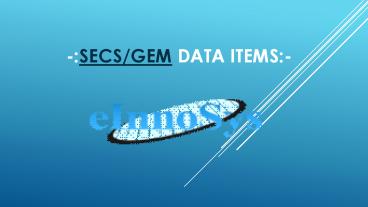SECS/GEM Data Items (1) - PowerPoint PPT Presentation
Title:
SECS/GEM Data Items (1)
Description:
SECS/GEM is an industry standard, that defines standard process of communication between equipment and fab host software for controlling and monitoring purposes. By connecting SECS/GEM equipment, fabs can immediately gain operational benefits. Factory hosts can collect data in multiple ways. Along with event reports, the fab host often requires to poll the equipment for current data values. The host can directly request Data values , or can be sampled periodically in a trace report this process is called Data Polling – PowerPoint PPT presentation
Number of Views:35
Title: SECS/GEM Data Items (1)
1
-SECS/GEM Data Items-
2
- SECS/GEM is an industry standard, that defines
standard process of communication between
equipment and fab host software for controlling
and monitoring purposes. By connecting SECS/GEM
equipment, fabs can immediately gain operational
benefits. Factory hosts can collect data in
multiple ways. Along with event reports, the fab
host often requires to poll the equipment for
current data values. The host can directly
request Data values , or can be sampled
periodically in a trace report this process is
called Data Polling.
3
- There are 3 categories of Data Items defined in
SECS/GEM standards-
4
- Status Variables (SV)-
- Status variables are data items that identify the
status of the equipment, or any of its
components, such as sensors, meters, etc.
Examples of status variables for process
equipment are Temperature, Pressure, Gas Flows,
RF Forward Power, Spin Speed, etc. These data
items are generally not attached to events such
as lot start, wafer start, etc. A factory host
can query the status variables to the equipment
any time or can define trace data setup through
which it asks the equipment of supplying status
variables at regular intervals. A factory host
cannot change status variables of the equipment.
5
- Data Value Variables (DV)-
- Data value variables are data items that are
related to a certain event, such as lot start,
alarm/error occurring on the equipment, wafer
processing/measurement complete, etc. Examples of
data value variables are Lot ID, Slot Number,
Current Recipe, etc. These variables change only
when a certain event occurs, such as selecting a
recipe, starting lot processing, etc. A factory
host queries Data Value variables through
defining reports and associating the reports to
events. - Unlike status variables, data value variables may
not have a value. For example, one of the data
value variable is Alarm ID, which designates the
ID of the most recent alarm. However, it can be
empty if there havent been any alarms since the
equipment was turned ON. A factory host cannot
change the data variables of the equipment.
6
- Equipment Constants (EC)-
- Equipment constants are data items related to the
configuration of the equipment they could
contain items related to the equipment hardware,
software or SECS/GEM software. Unlike status
variables and data value variables, a factory
host can change equipment constants through SECS
messages. Examples of equipment constants are
Pump Down Time Limit, Equipment Standby Time,
Pins Up Wait, etc.
7
- Data Properties
- The Data types listed above have similar
properties so that its convenient to define the
data. The equipment supplier is required to
provide these properties in a SECS/GEM manual so
that the fab host will be able to understand and
communicate with the data. Below are some of the
important data properties of the Data Types
- ID Its a numeric ID that must be unique in the
SECS/GEM interface. These IDs can be grouped by
data type and are referred to as SVIDs (Status
Variable IDs), DVIDs (Data Variable IDs) and
ECIDs (Collection Event IDs). - Name Its a name assigned to a data item so
that we can identify it easily. - Format Data type of the item.
8
- Data formats can be simple (numeric, ASCII,
Boolean) or complex (arrays, lists, structures).
For example, numeric types can be I1, I2, I4, I8
(signed integer types of different byte length),
U1, U2, U4, U8 (unsigned integer types) and F4 or
F8 (floating point types). - Array types and List contain multiple values in
the data item. For example, image data will be
formatted as a Byte Array. - Structure types contain a specific type of data.
For example, a variable may represent a slot map
which contains carrier information and also list
of slots with their wafer placement status. - Value Its the actual value of the data item.
Data values are in an accurate, efficient,
selfdescribing binary format so that its easy for
the host to interpret the data. The data format
allows collection of more data and with more
efficiency. - Alarms Collection Events (CE) also have IDs and
names for their identification.
9
Data Polling- The fab host often gets data on a
regular intervals through event reports trace
reports and that it defines. SECS/GEM also
provides a system for the fab host to poll data
based on its needs. www.einnosys.com
info_at_einnosys.com














![ONE-LINERS for [Web]FOCUS Efficiency PowerPoint PPT Presentation](https://s3.amazonaws.com/images.powershow.com/5524009.th0.jpg?_=20141006069)
















